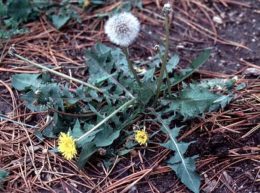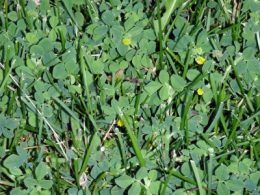 A weed is a plant out of place! Dandelion sure fits that definition! Dandelion is a perennial herb that forms a rosette in lawns and gardens. Inflorescence composed of yellow ray florets that give rise to a “puffball” head. New plants germinate primarily in the fall (late September). Mid-October and November is the most effective time to control broadleaf weeds, including dandelions in lawns. Dandelion usually produces a flush of new plants in late September. These young plants are small and easily controlled with herbicides such as 2,4-D or combination products (Trimec, Weed-B-Gon, Weed-Out) that contain 2,4-D, MCPP and Dicamba. Even established dandelions are more easily controlled in the fall rather than in the spring because they are actively moving materials from the top portion of the plant to the roots. Herbicides will translocate to the roots as well and will kill the plant from the roots up. Be sure to choose a day that is 50 degrees or higher. The better the weed is growing, the more weed killer will be moved from the leaves to the roots. Cold temperatures will slow or stop this process. Weed Free Zone (also sold under the name of Speed Zone) contains the three active ingredients mentioned above plus carfentrazone. It gives a quicker response than the other products mentioned and will work better when temperatures drop below 50 degrees.
A weed is a plant out of place! Dandelion sure fits that definition! Dandelion is a perennial herb that forms a rosette in lawns and gardens. Inflorescence composed of yellow ray florets that give rise to a “puffball” head. New plants germinate primarily in the fall (late September). Mid-October and November is the most effective time to control broadleaf weeds, including dandelions in lawns. Dandelion usually produces a flush of new plants in late September. These young plants are small and easily controlled with herbicides such as 2,4-D or combination products (Trimec, Weed-B-Gon, Weed-Out) that contain 2,4-D, MCPP and Dicamba. Even established dandelions are more easily controlled in the fall rather than in the spring because they are actively moving materials from the top portion of the plant to the roots. Herbicides will translocate to the roots as well and will kill the plant from the roots up. Be sure to choose a day that is 50 degrees or higher. The better the weed is growing, the more weed killer will be moved from the leaves to the roots. Cold temperatures will slow or stop this process. Weed Free Zone (also sold under the name of Speed Zone) contains the three active ingredients mentioned above plus carfentrazone. It gives a quicker response than the other products mentioned and will work better when temperatures drop below 50 degrees.
Tag: Weed Control
Fall Season Weed Control
 We often don’t think of weed control occurring in the fall of the year. Some weeds need to be treated in the spring such as crabgrass. Late October to early November is the most effective time to control broadleaf weeds in lawns. Dandelions usually produce a flush of new plants in late September, and the winter annual weeds henbit and chickweed should have germinated in October.
We often don’t think of weed control occurring in the fall of the year. Some weeds need to be treated in the spring such as crabgrass. Late October to early November is the most effective time to control broadleaf weeds in lawns. Dandelions usually produce a flush of new plants in late September, and the winter annual weeds henbit and chickweed should have germinated in October.
These young plants are small and easily controlled with herbicides such as 2,4-D or combination products (Trimec, Weed-B-Gon, Weed-Out) that contain 2,4-D, MCPP and Dicamba. Even established dandelions are more easily controlled now than in the spring because they are actively moving materials from the top portion of the plant to the roots in the fall. Herbicides will translocate to the roots as well and will kill the plant from the roots up.
Choose a day that is 50 degrees or higher. The better the weed is growing, the more weed killer will be moved from the leaves to the roots. Cold temperatures will slow or stop this process. Weed Free Zone (also sold under the name of Speed Zone) contains the three active ingredients mentioned above, plus carfentrazone. It will give a quicker response than the other products mentioned especially as temperatures approach 50 degrees.
Fall Bindweed Control
Field bindweed is a deep-rooted perennial weed that severely reduces crop yields and land value. This noxious weed infests just under 2 million acres, and is found in every county in Kansas. Bindweed is notoriously hard to control, especially with a single herbicide application. The fall, prior to a killing freeze, can be an excellent time to treat field bindweed — especially when good fall moisture has been received. This perennial weed is moving carbohydrate deep into its root system during this period, which can assist the movement of herbicide into the root system. Continue reading “Fall Bindweed Control”
Continue reading “Fall Bindweed Control”
Weed Control Strategies in Grain Sorghum
Severe grass and broadleaf weed pressure will reduce grain sorghum yields and can make harvest very difficult. Good crop rotation and herbicide selection are essential components of managing weeds in grain sorghum.
In a wheat-sorghum-fallow rotation, it is essential that broadleaf and grassy weeds do not produce seed during the fallow period ahead of grain sorghum planting. It is equally important that winter annual grasses are not allowed to head in spring, before the sorghum is planted. Continue reading “Weed Control Strategies in Grain Sorghum”
